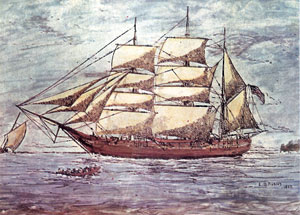11 October 2007 Edition
Setting a Course for Freedom

TV Review:
Hidden History.
The Catalpa Rescue
RTE 1,
Tuesday 9 October
BY PHILIP CONNOLLYHidden History.
The Catalpa Rescue
RTE 1,
Tuesday 9 October
Including the published memoirs of Captain George Anthony, John Devoy and John Breslin, the hugely enjoyable Hidden History series on Tuesday night told the story of The Catalpa Rescue.
On 17 April 1876, having suffered deportation to the most horrific of prisons in Western Australia, six Fenian prisoners were sprung from the formidable Fremantle prison, known as ‘The Establishment’. Having been rescued by John Breslin, sailing to the U.S and their freedom, the Catalpa rescue is regarded as the bravest prison break in history.
The story started with the infiltration of the British army by the IRB. John Devoy headed the recruitment drive among the soldiers in order to topple British rule from within Ireland in what would have been an unprecedented mutiny.
In all the Fenians had 15,000 members in the British army, 8000 of which were based in Ireland. The plot was discovered by the British and the “military Fenians” were deported to Australia to spend the rest of their lives as slave labourers to build the roads of the empire. John Devoy was exiled to the US on account of his civilian status.
Devoy, a leading member of Clan na Gael, living in the US, received a letter from fellow Fenian James Wilson who had spent eight years in Fremantle Prison, western Australia. Wilson’s “letter from the tomb” echoed the Fenian refusal to accept their status as criminals, and was a powerful call for action by Can na Gael in the US. Devoy set about an audacious plan to rescue the six Fenian prisoners.
Devoy organised funds through expatriates in the US to buy and refit the whaling ship The Catalpa. The Fenians found a suitable captain for the mission in the surprising shape of George Anthony, a non-conformist, temperance Protestant, who, having recently retired, agreed to take part in the operation purely because “it was the right thing to do”. He sailed with his crew out of Massachusetts bound for Western Australia on the 29 April 1875.
Having successfully sprung Fenian leader James Stephens from a British jail, John J. Breslin was recruited in the United States to take charge of the rescue mission. This he did with great stealth. Disguised as the American millionaire businessman, James Collins, Breslin departed for Australia in September of 1875. He won the confidence of the authorities in Fremantle who believed that he was in the colony to spend vast sums of money buying up huge swathes of land for forestry and mining interests.
The subterfuge worked and even lead the authorities into giving Breslin a guided tour of Fremantle Prison to view the slave labour that would be available to him for his enterprise. This tour of the prison convinced Breslin that the prison was so heavily guarded that he could only spring the Fenian prisoners when they were working outside of the jail.
Captain Anthony and his whaling ship arrived off the coast of Australia three months behind schedule. Not knowing for sure if the ship had sunk, Breslin was to discover that Fenians from New South Wales were also in Fremantle planning to spring their six comrades from the prison. This was further complicated by the appearance of two Fenians who had travelled from Ireland with their own plan to do the same!
Breslin enrolled the services of all of the Fenians but the departure from Ireland of the two IRB members attracted the attention of the British, and this threatened to compromise the entire operation. Breslin was also running out of funds, without which the subterfuge could not last. Fortunately the Fenians in Australia come to his aid and bought him enough time to see the mission through.
On news of the arrival of The Catalpa, Breslin sent word to the prisoners to prepare to be rescued on the following Monday. The rescue went ahead and the six prisoners having won the confidence of their jailers were allowed to do work around the outside of the prison grounds, so desolate was Fremantle that there was nowhere to escape to, with desert to the east and shark-infested waters to the north and west.
John Breslin extricated the six prisoners and they made good their escape on Easter Monday. In a 20-mile dash southward to Rockingham, the prisoners and Breslin were already on the beach before word reached the British of the their whereabouts.
After several attempts to intercept it, the British, sailing in a steamer ship caught up with The Catalpa and threatened to sink it with 12-pound cannon. Captain Anthony unfurled the US flag which, being on the high seas, brought some protection for the vessel. There was no wind to catch her sails as the British tried to nudge The Catalpa back into the three-mile territorial waters, where she could be legally boarded.
The stand off continued until, suddenly, the wind picked up and the Fenians set sail for a heroes welcome in the United States, where four months later, hundreds of thousands turned out to welcome them.
In Dublin a torchlight procession was held to celebrate the victory of the daring raid and the refusal at all costs, of those who fought for Ireland’s freedom, to be labelled or treated as criminals.


